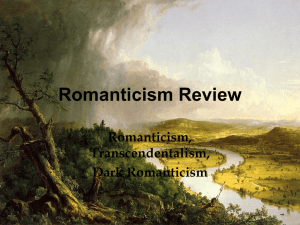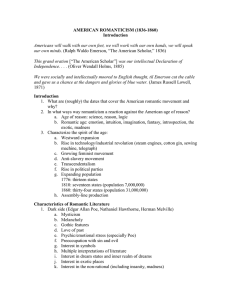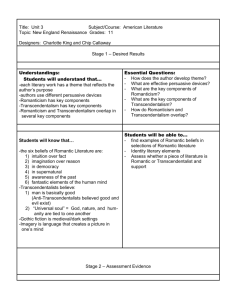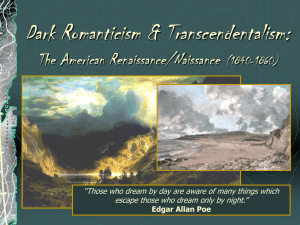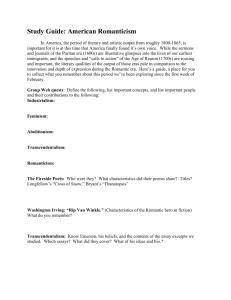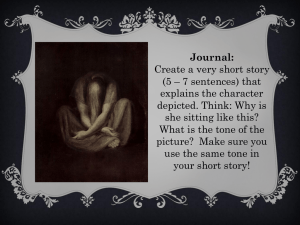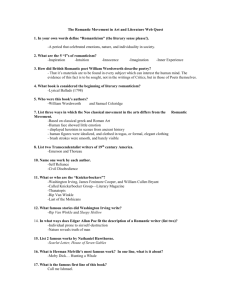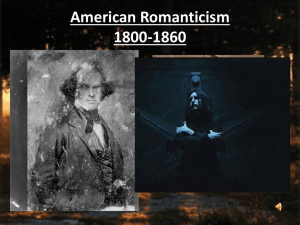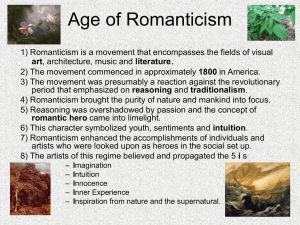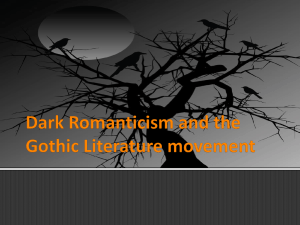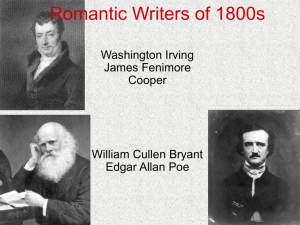Romanticism Review - St. John Vianney High School
advertisement
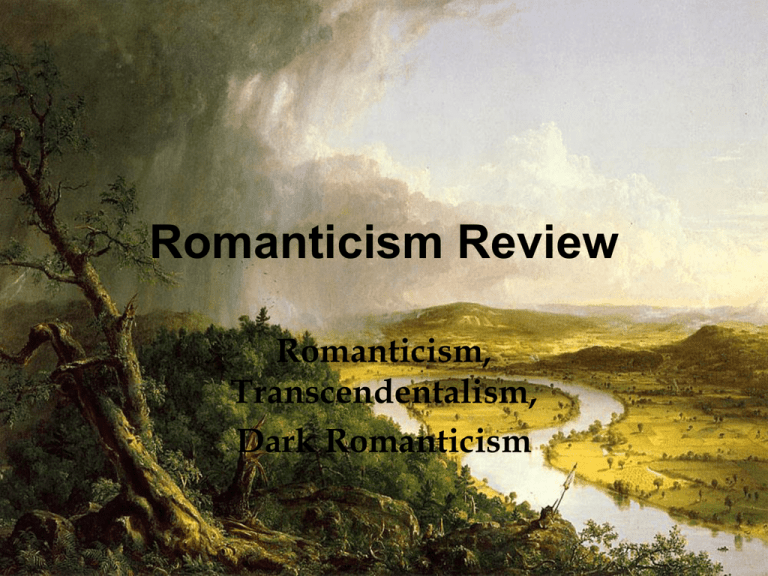
Romanticism Review Romanticism, Transcendentalism, Dark Romanticism Romanticism Romanticism is a cultural and literary philosophy that was popular in the United States from roughly 1800-1865. The Romantic movement began as a sort of rebellion against stringent Rationalism. We are no longer colonial and we are self-reliant. Uniquely American scenes, characters and themes. This is the first time America has its own literary movement—short stories, novels, poetry that have an American sense. The Romantic movement includes the other philosophies of Transcendentalism and Dark Romanticism. Elements of Romantic Literature • It values feelings and intuition over logic and reason • It shuns the artificiality of civilization for the unspoiled nature • It looks back to the wisdom of the past and distrusts progress • It champions individual freedom and the worth of the individual • It places faith in the power of imagination—poetic sense • It contemplates nature’s beauty as a path to spiritual development • It finds beauty and truth in the natural and supernatural realm • It seeks Truth—attainable through seeing the Divine Spirit/God in nature • It usually includes some type of journey from the civilized, urban world to the idealized, natural world Characteristics of the Romantic Hero He is innocent and pure of purpose He has a sense of honor based on higher principles than those of society Has knowledge of people based on intuitive understanding He loves nature and avoids urban life He quests for some higher truth and is of higher moral character Transcendentalism This movement is an offshoot from Romanticism. It is as much a social, cultural movement as it is literary. Most of the persons of note were social and cultural activists. This philosophy saw the potential in mankind but that he is somewhat blinded by the modern world. Simplify, Simplify, Simplify Tenets of Transcendentalism The simplicity of nature is a pathway to the Divine Soul Commercialism, materialism and industrialism are dehumanizing and corrupting Man is perfectible—spiritual journey Truths are attained through intuition and experience Idealistic and optimistic, leaders sought improvement through social change: abolition of slavery, improvements in public education, equal rights for all, including the poor, indigent, mentally ill. Emerson and Thoreau Ralph Waldo Emerson was the leading speaker and thinker in the transcendentalist movement. He was the leader of the Lyceum Movement. Henry David Thoreau was a follower of Emerson but chose to live the life of a transcendentalist. Removed himself from society and showed that living the simple life was possible. He was a strict believer in Human Rights and that man had the right to seek his own path in the world without the constrains of government. His time at Walden Pond was an experiment in simple living. Dark Romantics Although the authors followed the literary styles of the Romantics, many of their themes focused on the dark side of human nature Emphasis on how sin and guilt are strong influences Also saw the influences of supernatural, spiritual and superstition. Nature can also be cruel and immutable force. Edgar Allan Poe Poe was born in Boston in 1809. Mother separated from his father and then died in 1811. (Edgar did not know his father.) He was adopted by John Allan, wealthy and influential. He struggled with family (father) and school by the time he went to college, and was forced to eventually join the army, where he was also dismissed. He was not an initial success and although his writing became more and more popular his drinking and lifestyle limited his financial gain. He married his 13 year old cousin. She died in 1847 which continued his downward mental spiral. He began drinking at a young age and heavy drinking continued throughout his life. After his wife died in 1847, he lost touch with reality, failed at most of his professional endeavors and fell into an alcoholic stupor. He died in 1849, being found alone and delirious in a public house. Edgar Allan Poe Although he was a prolific writer of short stories and poetry, during his life he was more successful as an editor and critic, being put in charge of two very successful and influential periodicals. His style falls under and almost defines the “Dark Romantic” era, being one of its most prolific writers (eventually). The darker images of his poetry are often lost in his lyrical, poetic qualities. His poems and short stories often follow a pattern and include images of loss, loneliness, death, sorrow, mental anguish, and sin and guilt. Many people equate this with his own “disordered brain”. The Short Stories of Poe “The Masque of the Red Death” An Allegory about the inevitability of death Seems to draw from Poe’s life experiences with the “Red Death”—tuberculosis. All guests move slowly toward the last room where the Red Death resides despite Prospero’s preparations. “The Black Cat” A story that is evidently a commentary on the evils of alcohol, something Poe dealt with his adult life. The main character, the narrator, like many of Poe’s narrators/character, harbors some disturbing psychosis which eventually leads to his undoing. By the story’s end he is preparing for his own ultimate end. The Fireside poets The Fireside Poets were socalled because they incorporated simple language and ideas into lyrical easy-todigest poems. They were the rock stars of their day. William Cullen Bryant Oliver Wendell Holmes Henry Wadsworth Longfellow were just a few of the poets of the time who also included many natural elements into their poetry Imagery and Metaphor were commonly used poetic elements Walt Whitman Walt Whitman’s career spans the entire Romantic era and beyond from the 1840s to almost 1900. He is the Everyman and the voice of the lower classes (for almost the first time?) His quintessential work, Leaves of Grass, was revised many times before his death. His emphasis is on Man’s relationship to the Natural world but also on Man’s relationship to one another. Washington Irving Irving is considered by many experts to be the first great American author of fiction. His short stories and novellas capture the Romantic ideals of capturing the innocence of the past, their rural settings, their reference to the natural and supernatural world and their general reference to a moral or lesson. “The Legend of Sleepy Hollow” contains many of these same elements including the moral of greed. Nathanial Hawthorne A significant writer of the Dark Romantic movement, Hawthorne may be best known for his novel The Scarlet Letter. Most of his writing deals with the repercussions of hidden sin, especially that of lust or greed, and the sin people keep within themselves, while holding themselves up as paragons of the community. “Young Goodman Brown” deals with many of these same ideas. The main character believes himself virtuous, he revels about a “satanic” ritual that includes most of the people he knows or loves. He is forever changed because he cannot see beyond his vision and only sees the evil in his community.
